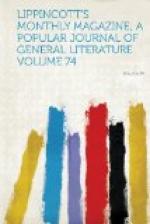Reaching Stamboul, we made our way through the crowded streets, past the Seraglio gardens and St. Sophia, till we reached the old Hippodrome, which was modeled after the Circus at Rome. Little remains of its ancient glory, for the Crusaders carried off most of its works of art. The granite obelisk of Theodosius and the pillar of Constantine, which the vandal Turks stripped of its bronze when they first captured the city, are still left, but the stones are continually falling, and it will soon be a ruin. The serpentine column consists of three serpents twisted together: the heads are gone, Mohammed II. having knocked off one with his battle-axe. A little Turk was taking his riding-lesson on the level ground of the Hippodrome, and his frisky little black pony gave the old fellow in attendance plenty of occupation. We watched the boy for a while, and then, passing on toward the Marmora, took a look at the “Cistern of the Thousand Columns.” A broad flight of steps leads down to it, and the many tall slender columns of Byzantine architecture make a perfect wilderness of pillars. Wherever we stood, we seemed always the centre from which long aisles of columns radiated till they lost themselves in the darkness. The cistern has long been empty, and is used as a ropewalk.
The great fire swept a large district of the city here, which has been but little rebuilt, and the view of the Marmora is very fine. On the opposite Asiatic shore Mount Olympus, with its snow-crowned summit, fades away into the blue of the heavens. This is a glorious atmosphere, at least at this season, the air clear and bracing, the sky a beautiful blue and the sunsets golden. In winter it is cold, muddy and cheerless, and in midsummer the simoom which sweeps up the Marmora from Africa and the Syrian coast renders it very unhealthy for Europeans to remain in the city. The simoom is exceedingly enervating in its effects, and all who can spend the summer months on the upper Bosphorus, where the prevailing winds are from the Black Sea and the air is cool and healthful. Nearly all the foreign legations except our own have summer residences there and beautiful grounds.
[Illustration: OBELISK OF THEODOSIUS.]




